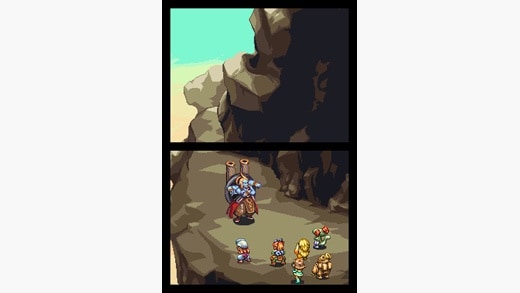You can trust VideoGamer. Our team of gaming experts spend hours testing and reviewing the latest games, to ensure you're reading the most comprehensive guide possible. Rest assured, all imagery and advice is unique and original. Check out how we test and review games here
Starting life on the GBA, the Magical Starsign series makes its debut in the west on the DS, and despite the astrological title it’s actually a fairly grounded RPG.
You’d think that the potential of a stylus-based interface would have brought far more RPGs to Nintendo’s handheld, but the machine is actually fairly starved of the genre, so it’s a pleasure to discover that the relatively obscure Magical Starsign is a reasonably good, if not revolutionary, little RPG.
The plot sees you and your gang of enthusiastic schoolmates set off on a planet-skipping adventure through space on a mission to rescue your beloved teacher, recently missing from the academy of magic and sorcery that is the hub of your daily life.
From the off the game is sickly sweet. There is no doubt that this is a release targeted equally at younger audiences and adult gamers, but the style of the graphics and audio is so overwhelmingly cute that they are clearly designed to appeal to the under tens.
In fact, cute may be an understatement. Magical Starsign is so gushing with sweetness and light that it makes the Zelda games feel more like the tormented horror series Project Zero. Thankfully, the game is interjected with enough daft and cheeky humour to hold the attention of the more mature player.
But that is where most of the comparisons with Nintendo’s flagship RPG end. Magical Starsign may be brimming with cuddly characters and cartoon dungeons, but it is still a traditional 2D RPG that sees you exploring an isometric world, talking with the strange creatures you meet and indulging in number crunching random battles.
It is certainly one of the more accessible of the Japanese RPGs and, though it gets complex in places, it would make a great introduction to a genre than can often be overwhelming to the newcomer. There is also enough strategy and atmosphere for the avid role-player, but the combat system is fairly standard.
As you explore, gathering clues and items, you stumble into battles with deceptively meek looking aliens. Taking turns, you and your foes can choose to make magical or physical attacks, whittling away at your victims’ HP until you defeat them. Various healing potions, magical items and defensive techniques can be employed, but the game never demands too much of the player, meaning developing basic strategic patterns of defending and attacking with the ideal member of your team is fairly easy.
Things begin to get complicated when the astrology becomes involved. Rather than predicting the future of your enemies’ movements by using a completely fictitious science from the back pages of glossy magazines, the technique focuses on the positions of the planets and stars at the time of battle, and the conflicting star signs of your team and your foes.
Every character in the game has his or her own elemental star sign in a relatively simple system that is far easier to understand in practice than on paper. Each sign is stronger than a specific other, but can be overpowered by another, in a paper, scissors stone situation. Water beats fire for example, and fire beats wood, and on it goes until the structure runs full circle, where earth beats water. What this actually means in a combat situation is that if you are attacking a character with the star sign you defeat most easily, your attack is more powerful. To succeed in a brawl you must carefully choose which team-mate to use on which enemy in a group melee situation.
Your characters’ star signs also link them to one of five elemental planets, orbiting around the sun at the centre of the game’s universe. That solar system is divided into five colour-coded elemental areas in the fashion of a pie chart, meaning that if, for example, you have an earth element character, their combat strength will be optimised when the earth planet is in the earth area of its orbit. Again, though this sounds complex, applied to the game it functions as a simple and accessible strategic device.
Confusing things a little more still, at the start of the game, when you choose the gender and name of your avatar, you must also assign yourself not a elemental sign but a light sign. Separate from the element cycle, you choose a light or dark path. Rather than having solar orbits dictate your power in battle, light characters are stronger in the daytime and dark characters are stronger in the night, with the two periods rotating on a 20-minute clock.
Beyond these fundamental strength devices, there are a handful of other techniques. The first is not original to Magical Starsign, but relatively well implemented here. In battle, your characters can assume their position on the front or back row, as do your enemies. Physical attacks can only reach the front row, lending the back row a defensive advantage. Magic, however, can be hurled over to the back row, spreading out to impact every character there, with its power divided evenly between them. The other technique, introduced some way into the game, lets you boost offensive power with a well-timed tap of the stylus on any character as they cast magic.
Outside of the battling system that is the core of the game, the stylus works well to guide your avatar and talk with friendly aliens, and the top screen is taken advantage of brilliantly to hold the various menus and maps, which can be scrolled through one at a time. The dialogue is well written and the plot solid, lending the game the trademark Nintendo feel of quality.
Magical Starsign offers nothing particularly original or special to appeal to the RPG fan that doesn’t have a particular interest in this cute eastern subgenre, but for the casual gamer and RPG newbie it is a gentle and well-crafted introduction to a rich and complex area of gaming.

/https://oimg.videogamer.com/images/df2a/magical_starsign_8.jpg)






